Keeping your trees looking smart with regular pruning not only increases your home’s curb appeal but also keeps the tree healthy and safe.
Tree pruning companies are used for pruning large or dangerous trees. This can include trees leaning over homes, near power lines, or just too large to get to with conventional climbing equipment.
Poorly maintained trees can quickly become a hazard with falling branches or breaking branches.
The average cost to prune a tree is $438 going by the current market rates.
However, costs can range between $120 to $1200 depending on factors such as the size of the tree to be pruned, location, amount of pruning to be done, season, and type of tree. Professional tree pruning companies will want to get a clear description of the trees(s) to be pruned or do a survey before they can give a final quote.
Here is a detailed guide on tree pruning costs based on the factors mentioned above and how you can ensure that you are getting the best deal:
| Service | Size | Low | High |
|---|---|---|---|
| Average tree Pruning cost | 15 – 50 ft. + | $120 | $1200 |
| Large tree pruning cost | 50 ft. + | $490 | $1200 |
| Medium tree pruning cost | 30 – 40 ft. | $225 | $720 |
| Small tree pruning cost | 15 – 25 ft. | $120 | $390 |
Large Tree Pruning Costs
Pruning a large tree that is above 20 feet in height can cost anything between $720 to $1,200. The costs vary depending on the type of tree, working conditions, and where it is located. For instance, pruning a large Ash tree in an open part of your yard could cost $410 while it could cost $720 to prune a similar-sized tree that is growing inside a garden or near an aerial powerline.
Medium Tree Pruning Cost
A medium tree that is between 30 to 40 feet tall will cost $425 to prune on average.
Medium-sized trees are usually young trees with little to no deadwood to deal with making the job easier when it comes to pruning.
Small Tree Pruning Cost
A small tree in this case refers to any tree that is between 15 to 25 feet in height. Such trees could cost anything between $225 to $720 to prune depending on the amount of pruning to be done and where they are located.
Tree Pruning cost by style
Pruning costs may also depend on the type of work to be done. For instance, is the pruning focusing on removing deadwood or is it about canopy cleaning? Here are some rough estimates of the amounts you may pay for different pruning services assuming that you have a medium-sized tree to be worked on:
| Service | Qty Avg | Low | High |
|---|---|---|---|
| Crown reduction | 5 hrs | $750 | $1,800 |
| Dead-wooding | 2 hrs | $250 | $750 |
| Canopy lift | 1.5 hrs | $190 | $690 |
Crown reduction
A crown reduction is the most expensive prune of all. On average it will cost $1,100 to reduce the crown of a medium-sized tree. This is because the outer edges of the tree need to be reached. This is very time-consuming as you can imagine trying to reach the hardest to get to the part of the tree over the whole tree, as opposed to just removing one of the tree’s lower branches.
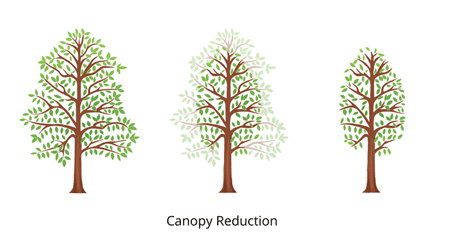
Dead wood removal
Pruning aimed at getting rid of dead or decaying branches will cost anything between $250 to $750 for a medium-sized tree. This is the most common type of pruning and probably one that you will need to budget for every few years if you have trees in your yard. Removing deadwood reduces the burden on an otherwise healthy tree to encourage new offshoots. It can also be done to eliminate the chances of the deadwood falling off in bad weather and becoming dangerous projectiles.
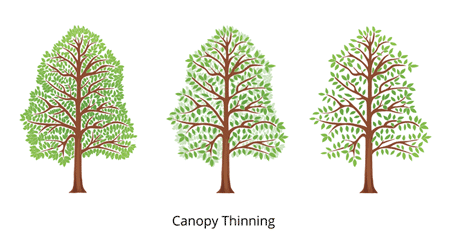
Canopy lift
A canopy lift is a process of removing the lower branches of a tree to essentially raise the canopy of the tree further off the ground. Generally, this is one of the cheaper trimming jobs and will cost you $420 on average.
This is great for letting more light through to your home or onto your lawn to encourage grass growth.
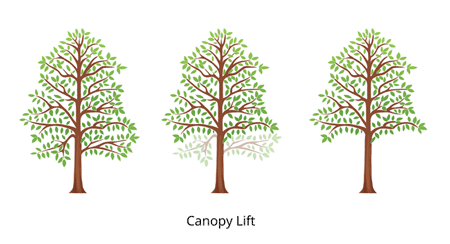





Difference Between Pruning and Trimming
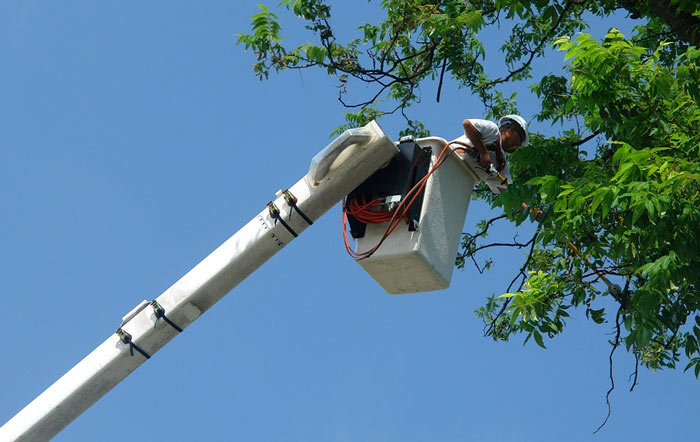
Both pruning and trimming are essential to tree maintenance activities that you will need to do or have someone do for you. Trimming refers to cutting off sections of a tree to keep a certain shape or provide clearance for an aerial powerline, or nearby structures, or to reduce the crown density for various reasons. On the other hand, pruning is mainly done to improve the health of a tree by getting rid of damaged, dry or diseased branches and other limbs. Pruning is, therefore, more reactionary while trimming is done based on needs or as scheduled.
Sometimes both activities do overlap and workers will end up pruning while also trimming a tree. Trimming is usually required for a tree with dense canopies or those with large branches that may extend over other structures. It may also be required when you want to reduce the amount of shade so that smaller plants growing below the tree can get enough sunlight.
Differences
- Pruning involves removing dead, diseased unwanted branches from a tree.
- Trimming involves cutting healthy parts from a tree to the desired shape, thinning, or reducing the canopy.
- Professional trimmers focus on selectively healthy green shoots and limbs.
- Professional pruners focus on removing unwanted branches and limbs.
- Professionals use shears while pruning but may use saws for large trees and branches.
- Those doing trimming can use a trimmer, saw, or any other cutting tool.
Similarities
- Both activities improve the overall health and appearance of a tree.
- Both activities can be done for safety purposes.
- You can trim and prune at the same time. However, you should only prune when it’s trimming season and not the other way around to allow the tree to recover while it’s actively growing.
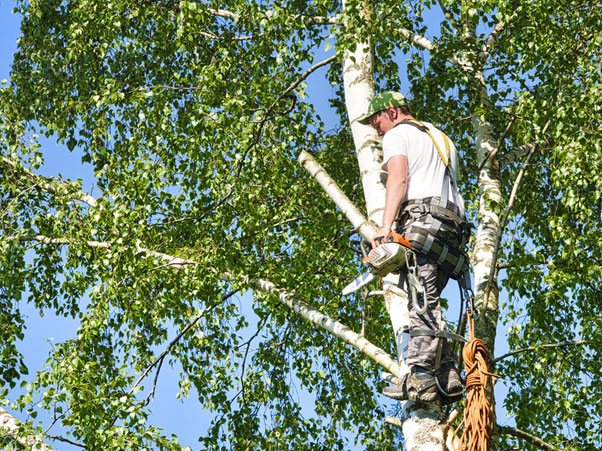
Hiring A Great Tree Pruning Company
With the number of tree maintenance companies out there, it can be confusing to choose one and also misleading if you base your decision on pricing. Here are some of the things you should look out for when selecting a tree pruning service:
1. Track Record and Experience
Do some research about the companies you have put on your shortlist. How long have they been in operation? Have they served clients near your location? Do they have good referrals and reviews? Can they share details of past projects they have worked on?
You should ideally select a tree pruning company that has been in operation for at least four years, has good testimonials and reviews, and has worked with local clients. You can find all this information online and during your discovery call before you commit.
2. Choose A Certified Company with Trained Staff
While pruning may appear as a simple manual task, you need to find out if the company has qualified employees who will do the job correctly. They should, at the very least have trained arborists or landscapers as supervisors or field officers who belong to a professional organization in your area.
3. Is the Company and Its Employees Insured?
Find out if the company provides some type of cover for their employees and if the company itself has insurance for third parties. This will help if one or more of their staff members are injured when they are working on your trees or if they cause damage to your property. The third-party insurance will pay for any damages caused by the company while they work on your trees.
4. Is the Company Licensed?
Make sure that the tree company is licensed by local and federal authorities to work in your location. Make sure that you sign a formal contract and get certifiable receipts for any work done on your yard for tax purposes. This will also help if there is a dispute along the way regarding work being done, payments, or accidental damage to your property.
Finding Tree Pruning Companies Near Me
There are a number of ways you can go about finding tree removal or pruning services near you. You should focus on finding companies that are nearest to your location so that you can save money and can contact them easily.
Do an Online Search
You can start by searching for tree pruning companies near you on Google. For instance, search for “tree pruning services near Houston” if you live in Houston TX. Google will do a local business search and display ads of businesses in your area that do pruning. However, the fact that Google or any of the other search engines prioritizes ads means you may not find the best company through the search alone. However, you can use this method to see what other people are saying about the companies on the review pages.
Use Go Tree Quotes
Go Tree Quotes is an online service dedicated to not only educating you about tree maintenance and care but also pointing you in the right direction when you need tree removal or tree pruning services. You can use the website to find tree pruning services that are certified, verified, and licensed to provide these and other tree-related services in your area.

FAQ's
Tree pruning can be done at any time of the year since it’s only meant to remove unwanted parts from your trees. However, early spring or late summer is the best time to prune as you can see the dry or unwanted branches and buds more easily. Some trees such as oaks should only be trimmed in winter to prevent diseases.
Winter is considered a low season for pruning so you might be able to get a better deal if you can get a company that is ready to prune in winter. However, winter pruning may not produce the best results and can be tricky because most trees are dormant at this point therefore making it difficult to distinguish healthy branches from dead or dry ones.
The amount you spend on pruning depends on the size of the tree, location, and other factors that may or may not be in your control. You can pay as low as $200 to have a medium tree pruned if you prepare the pruning site by clearing obstacles and providing better access to the pruning company. That said, pruning is a difficult task that can take several hours to complete.
Trees will develop new branches from the point where an old branch has been cut off. Sometimes, multiple offshoots will appear from the same location and develop into full-fledged branches. However, pruning should be done correctly to promote new growth.






